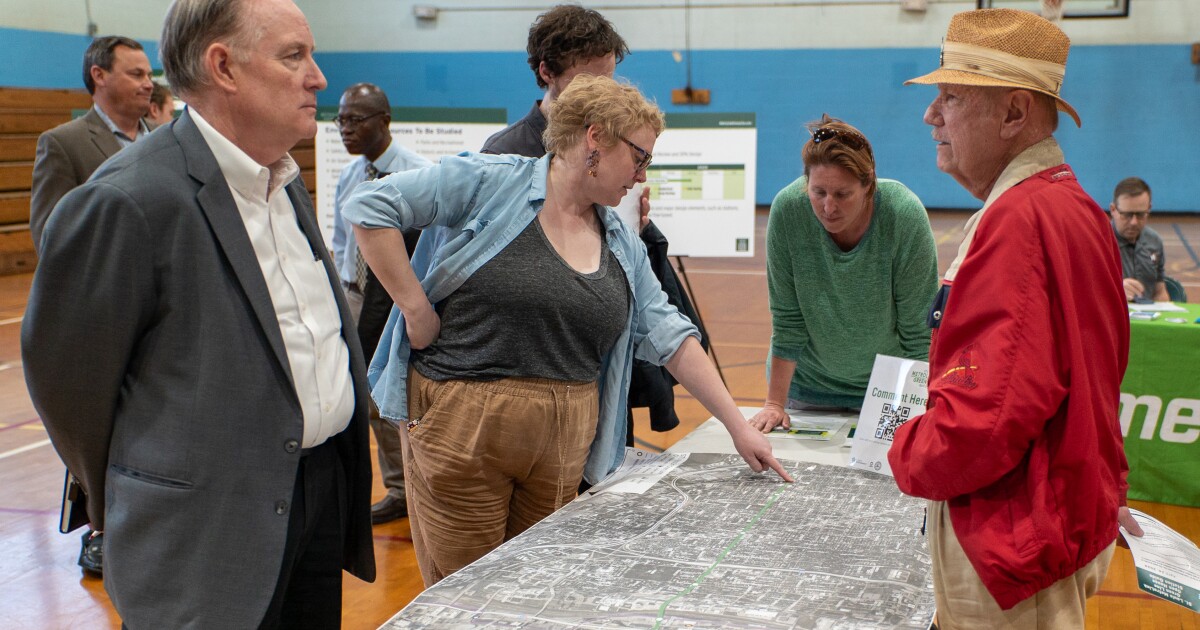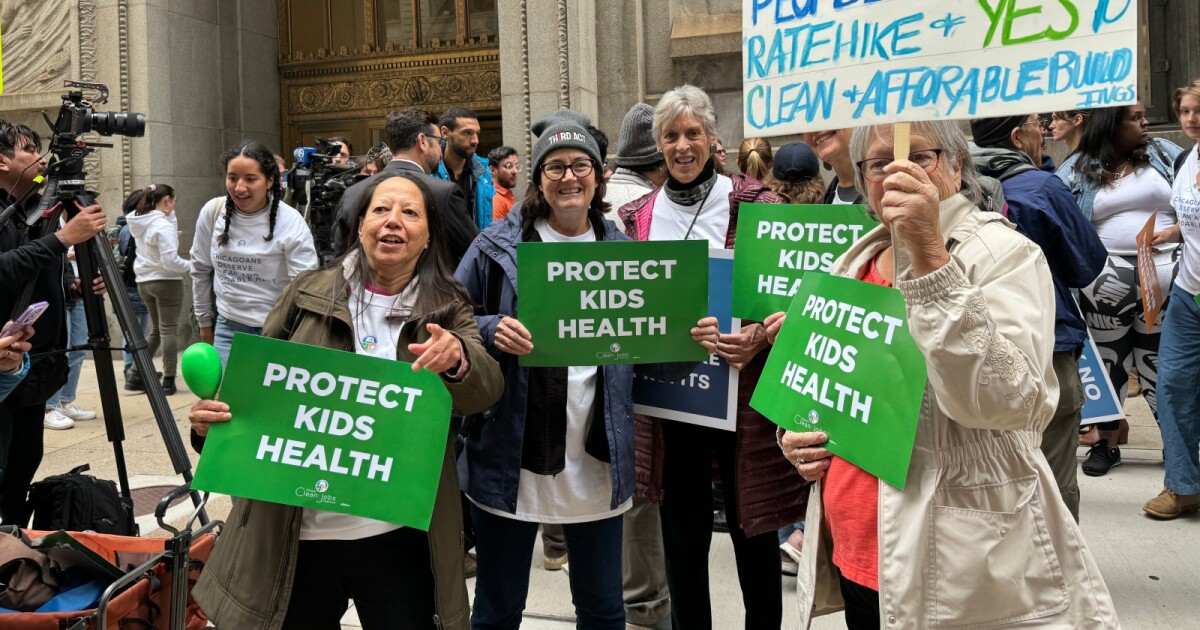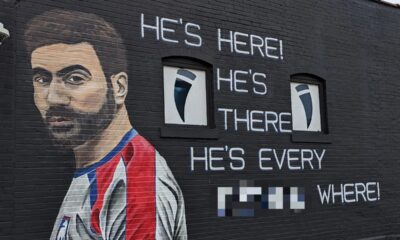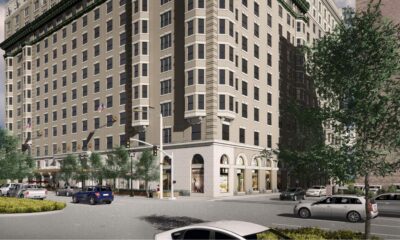Business
St. Louisans offer feedback on the MetroLink Green Line to connect north and south city

Residents across the St. Louis region seized opportunities this week to learn more about and offer feedback on a proposed 5.6-mile, north-south MetroLink expansion route called the Green Line.Bi-State Development led public meetings on Tuesday in north St. Louis and Wednesday in south St. Louis where attendees could read multiple posters about the proposed billion-dollar expansion and offer their direct feedback to members of the transit agency and its consultants on the project.The agency will host a virtual meeting next Tuesday as well.The meetings are meant to kick off the yearlong environmental review process and come after some of the initial design and engineering work that’s already been completed, said Jessica Gershman, assistant executive director of planning for Metro Transit.“It’s a chance for us to hear from the public,” she said. “[Making] sure we are unearthing all concerns about potential environmental impacts, and that we are figuring out how to mitigate anything that might arise.”That includes noise, vibration to property, impacts to green spaces, historic preservation and others, Gershman said.Some residents at Wednesday’s meeting raised specific concerns, such as how construction may affect their historic home, but many arrived simply wanting more information about the massive proposed project.“I wanted to know more about the changes to the alignment,” said Downtown resident Joseph Gordon. “It looked like a few of the stops were removed. I also wanted to know about the plans for the bike lanes on this alignment.”Benton Park resident Mary Clemens said she came to the meeting without much knowledge of the project and wanted to see how it compared to other options.“It’d be exciting to have this but also that I’ve heard people talking about why don’t we just get electric buses and save all the money and the work that you’re putting into this?” she said. “Why do people think this is a really great option as opposed to something else that you have a little more [flexibility]?”Gordon and Clemens shared other attendees’ feelings, lamenting how limited St. Louis’ current public transportation offerings are.“I’ve taken the bus here a few times — didn’t care for it,” Gordon said. “I would love to sell my car. Don’t even get me started. All these payments for this old piece of junk just to keep it alive.”
Eric Schmid
/
St. Louis Public RadioMary Clemens, of Benton Park, points out a detail of the proposed MetroLink Green Line to Joseph Gordon, of Downtown, on Wednesday during a community feedback meeting in south St. Louis.
Many residents said they have to drive even if that’s not their preference, but the proposed Green Line would alleviate that reliance. Tower Grove East resident Suzanne Hart said a major barrier to public transit use is how infrequent buses and trains are compared to other major cities like Washington, D.C., or Chicago.“In those cities, one of the reasons transit can be so robust is because it’s the easiest choice to make, and I would love to see that be the case here,” Hart said. “I unfortunately do a lot more driving than I want to. Having a north-south [light rail] alignment when the city is north-south aligned to begin with would be awesome.”Hart added she hopes the Green Line could catalyze better transit service in the region by offering a spine that more bus routes could build off of.“Any transit system worth its salt operates on multiple levels. Not only do you have a rail element but also buses and ideally good walking and biking.”But some attendees balked at the $1.1 billion price tag associated with the project.“I just feel like we’re putting our priorities out of whack,” said Gravois Park resident Charity Powell. “Can we get some improvements in the area and then maybe let’s talk about spending a billion dollars?”She said she wanted to see more direct investment into her community before spending a massive amount of cash on a train line that may not be highly used. “I feel like there are other things we can do to improve our public transportation without throwing away money.”Marine Villa resident Michael Ferguson agreed.“There are no destinations down here to justify spending this much money,” he said. “I have yet to see a full bus drive up and down Jefferson here.”But to Christina Goodwin, of Benton Park West, a train on Jefferson would go a long way to calming traffic in the way she wants to see. She added she’s been hit multiple times as a pedestrian on Jefferson.“One of the things St. Louis is really lacking is good infrastructure for transit and walkability,” Goodwin said. “It’s one of the ways in which it’s not up to [the caliber] of cities where lots of young people want to move. I think having Metro accessibility would make the difference for our neighborhood.”Gershman, with Metro Transit, said this kind of feedback is crucial for the project as it’s still in an early phase. The environmental review process will last another year with more opportunities for feedback from residents, neighborhood associations or meetings that the agency will incorporate into the design of the project, she added.“If people say, ‘Please come to my neighborhood meeting,’ we’re going to come,” she said. “We want to make sure that we are engaging with people and meeting them where they are.”The plan is to have the environmental review and project engineering completed for construction to begin in 2027, with service beginning in 2030, Gershman said.
Business
Group selling East St. Louis homes to use money on new projects
Editor’s note: This story was originally published in the Belleville News-Democrat.Faith-based nonprofit Lansdowne Up is preparing to sell some of the $360,000 homes it built in a new East St. Louis housing development, officials announced at a news conference and open house on Saturday.And the money from the home sales will go back into the community, according to Mark Mestemacher, founder and president of the Lansdowne Up board.Lansdowne Up is named after the Lansdowne neighborhood in East St. Louis that it’s working to redevelop.The nonprofit has been purchasing properties there to renovate or demolish existing houses and to construct new ones like those in the housing development, a 20-home subdivision called Lansdowne Park.Lansdowne Park is located at the corner of North 25th Street and Gross Avenue. Kevin Green, Lansdowne Up’s director of administration, said it had once been the site of a community park, an extension of nearby Jones Park. But over time the area became blighted.Now, some of the new three-bedroom homes are ready for occupancy and the nonprofit is looking for buyers. Other homes in the subdivision remain under construction, slated to be finished by the end of the summer.Mestemacher said the money they make will help them continue cleaning up properties in the neighborhood. The nonprofit also has plans for another housing development half a mile away from Lansdowne Park.
Joshua Carter
/
Belleville News-DemocratEmployees at faith-based nonprofit Lansdowne Up stand and watch a presentation of the new neighborhood they helped build on Saturday in East St. Louis.
Joshua Carter
/
Belleville News-DemocratEast St. Louis native and six-time Olympian Jackie Joyner-Kersee claps on Saturday during the presentation of the new Lansdowne Park subdivision in East St. Louis.
On Saturday, nonprofit leaders shared details about the next development, opened the finished homes for tours and addressed questions about their high cost in a community where about 30% of the residents live in poverty.Attendees included East St. Louis native and Lansdowne board member Jackie Joyner-Kersee, East St. Louis Mayor Charles Powell III, and three Illinois lawmakers: State Rep. Kevin Schmidt and State Sens. Chris Belt and Erica Harriss.NAACP East St. Louis branch president questions costs During the event, NAACP East St. Louis branch president Robin Carey-Boyd asked the nonprofit leaders how the average person in East St. Louis could afford a Lansdowne Park house. The median household income in the city is $28,519, according to U.S. Census Bureau estimates.“The average person is not going to be a resident in this particular neighborhood,” Green said in response to Carey-Boyd. “These homes are designed for the person from East St. Louis who has chosen to leave because they couldn’t find housing like this.”Lorenzo Savage, co-founder of I Am East St. Louis, The Foundation, said higher-value homes will help with the high tax burden homeowners currently face in East St. Louis. In cities with lower property values, the tax rate that determines how much each resident pays is higher.“It’s helping you with your taxes. And it’s encouraging other people to move back home,” Savage said. “… We need our people who work here to live here and have that money turning back over again like it did in the ’70s and ’80s, you know?”Mestemacher said the nonprofit worked with the city on an incentive for people who buy the $360,000 Lansdowne Park properties: a rebate on their taxes for the next 18 years, funded by a tax increment financing district.TIFs set aside some property taxes from the district for infrastructure improvements and economic incentives.
Joshua Carter
/
Belleville News-DemocratEast St. Louis Mayor Charles Powell III speaks to investors, politicians, press and residents on Saturday during the opening of the new Lansdowne Park subdivision in East St. Louis.
New housingAt the news conference and open house, Mayor Powell thanked the East St. Louis City Council and Illinois lawmakers for supporting the Lansdowne Park development with tax breaks and infrastructure funding.“Whatever it is, we need to do what we have to do to get developers to come and develop,” Powell said.Sen. Belt, D-Swansea, who represents East St. Louis in the General Assembly, said Lansdowne Park is just the beginning of development in East St. Louis.“There’s a synergy in East St. Louis,” Belt said. “This is the first step right here.”Lansdowne Up is currently working with the city on road and sewer infrastructure and a solution to the high property taxes for its next housing development in East St. Louis.Mestemacher called it the Nectar Avenue project. It will include shipping container homes.“There is a need for housing for young professionals. There’s a need for older individuals that are downsizing. So we have another project in the works,” Mestemacher said.Lexi Cortes is a reporter with the Belleville News-Democrat, a news partner of St. Louis Public Radio.
Business
Comcast-Bally Sports impasse keeps Cardinals games unavailable
St. Louis Cardinals fans who watch the games on Comcast Xfinity were thrown a curveball last week when Bally Sports Midwest disappeared from their service.Comcast and Diamond Sports Group couldn’t come to an agreement to keep Bally Sports Midwest and 11 other regional sports channels on the cable TV provider by the May 1 deadline.“Unfortunately, the Cardinals and Major League Baseball have no voice in this matter, but are hopeful the two sides will come to an agreement as soon as possible,” the team said last week in a statement.St. Louis Public Radio’s Brian Moline spoke with Evan Drellich, a senior writer for The Athletic who covers baseball business issues for the website, about the dispute and how it’s indicative of larger issues for Major League Baseball’s television rights.This interview has been edited for clarity and length.Brian Moline: Comcast is not the main cable TV provider here in the St. Louis metro area. But this does affect a large number of customers across the Cardinals broadcast territory. This has to be a pretty big hit for Bally’s, right? Evan Drellich: Yeah, it’s bad all around. And Comcast is offering a refund of $8 to $10 to any affected customer. So it’s hurting them too. It really is one of these situations where it’s hard to see who wins. And you would think the incentive would be for something to get done relatively quickly. I was told yesterday by somebody in baseball, not by somebody directly with either of these groups, that there could be some movement this week, but that we’ll see. I mean, that’s a secondhand piece of information. And we’ve seen these things drag on. Last year, Disney and Charter went for longer than anybody wanted, several weeks. So it’s really hard to predict how long these things will go.Moline: But let’s talk a little bit more about what Diamond and Comcast are fighting about here. Are we talking about total dollars? Or is there something else involved?Drellich: It’s always total dollars, you know. I cover the business of baseball, it’s a lot of off-field matters. And I would say 98% of stories I write, you could end the story with “it’s about money.” And I think that’s true for any business reporter inside or outside of sports. But the way the total dollars are reflected or show up here, it’s kind of interesting. It has to do with tiering. And so what Comcast wants to do is move the Bally RSN’s to a higher premium tier. And what that means is that there will be fewer people who receive the channel and therefore fewer people who are paying for it. And so at the end of the day, the tiering question ends up affecting the total dollars, but that’s the vehicle that they’re fighting over. And it’s a question of how quickly does that change happen? Are any customers grandfathered in? Where if you have it now, without the premium tier, how quickly do they get moved over? So the net dollars are what matter, but it shows up through this mechanism.Moline: What could the long-term effects here be, not only on a team like the Cardinals who’s been pretty successful with their regional cable network (Bally Sports Midwest), but broadcasts for Major League Baseball as a whole? Does this at all speed up maybe a move to some kind of a national streaming product?Drellich: I think this is part of a much larger issue overall in sports and in media generally. This is part of cord-cutting. It’s this evolving television landscape that really is going to drive everything in sports in coming years. You’re going to see a lockout in baseball in a couple of years, and one of the central issues will be how much money can teams still squeeze out of television deals? What does the television landscape look like? And so, oddly enough, this dispute between a television channel and a distributor, it’s really just kind of the head of the snake here. And it’s something that if you’re a sports fan, you know, the value of these TV rights and what these teams do with these TV rights is really going to underlie everything in the sports landscape for a number of years to come.
Business
Illinois utility bills may increase without spending control

Illinois ratepayers could see their gas bills soar over the next decade unless officials hit the brakes on spending from the state’s major gas utilities.
A report from the Building Decarbonization Coalition and Groundworks Data investigated what could happen if Peoples Gas, Nicor Gas, North Ameren Gas and North Shore continue to double down on a natural gas infrastructure system that flies in the face of the state and nation’s climate goals.
“Under the business as usual framework, customer rates in Illinois are on a trajectory to increase a good 50% by 2030,” said Dorie Seavey, a senior research scientist with Groundworks Data and primary author of the report. “And for most companies it is likely to double by 2035.”
Without meaningful intervention, that means the average residential bill could climb to approximately $650 a month during the coldest months by 2050.
Between 2014 to 2022, the state’s four largest gas utilities turbocharged their spending on gas infrastructure by more than $9 billion. Ratepayers will be paying these costs off for the next 40 to 70 years, according to the report’s authors. They warn that if state officials do not curb utility spending, “Illinois is on course to maintain its entire gas system indefinitely.”
There’s a direct line between what a utility spends and what ends up on a utility bill. Investor-owned utilities, like Peoples Gas, don’t turn a profit on selling fuel or energy. Instead, they’re authorized to recoup a rate of return on equity of just over 9% on their investments on massive infrastructure projects and upgrades. The costs of upgrades to the state’s network of thousands of miles transmission lines, distribution lines and underground storage — Illinois alone is home to over tenth of the nation’s total gas storage capacity — is spread across ratepayers over decades.
Keeping up with natural gas isn’t just getting more expensive for ratepayers. It’s also taking a huge toll on the climate.
Natural gas is primarily composed of methane, a greenhouse gas that can capture 80 times more heat than carbon dioxide for the first few years of its life cycle. Illinois ranks eighth in the nation for natural gas consumption, according to the U.S. Energy Information Administration. State and local leaders are pursuing policies to phase it out.
In 2021, Gov. JB Pritzker signed the Climate and Equitable Jobs Act, commiting the state to 100% clean energy by 2050. The law effectively sets a hard deadline to sunset the use of coal and natural gas power plants from the state’s power sector. It does not set any decarbonization targets for cutting natural gas from buildings. In Illinois, more than 80% of residents rely on natural gas to keep their homes warm.
Chicago’s City Council is following the lead of suburban Oak Park and pursuing an electrification ordinance that would phase out gas hookups in new construction. The ordinance is currently facing pushback from organized labor and gas utilities alike.
But as Illinois takes its first strides into an electrified economy, a big question mark hangs over who is left holding the bag when the gas customer base begins to split. When there aren’t enough customers to cover utility spending or even utilize the state’s immense gas system, Seavey calls that a “stranded asset,” or a liability — in this case, a massive one.
“Illinois can expect stranded asset risk on its books on the order of $80 billion by 2050,” Seavey said. That’s a sixfold increase. Right now, the unrecovered assets on the books of the gas companies are about $13.4 billion.
In Chicago alone, about 30% of gas customers are collectively $125 million in debt to Peoples Gas, according to Sarah Moskowitz, the executive director of the Citizens Utility Board. Utility spending at the current rate is already causing enough undue stress to communities across the state, she says throwing more money at utilities will only make it worse.
“Our state is already in the midst of an unmanaged gas transition,” Moskowitz said. “And an unmanaged transition is the most expensive kind of transition.”
The report comes as the Illinois Commerce Commission begins the second month of its Future of Gas proceedings, a series of public workshops evaluating how the current gas distribution system will have to adapt to meet the state’s decarbonization target.
As part of the ongoing proceedings, the ICC will hear the report Monday during a special briefing.This coverage is made possible through a partnership between WBEZ and Grist, a nonprofit, independent media organization dedicated to telling stories of climate solutions and a just future. Sign up for WBEZ newsletters to get local news you can trust.
-

 Entertainment1 year ago
Entertainment1 year agoSt.Louis Man Sounds Just Like Whitley Hewsten, Plans on Performing At The Shayfitz Arena.
-

 Business1 year ago
Business1 year agoWe Live Here Auténtico! | The Hispanic Chamber | Community and Connection Central
-
Board Bills1 year ago
2022-2023 Board Bill 189 — Public Works and Improvement Program at the Airport
-

 Local News1 year ago
Local News1 year agoVIDEO: St. Louis Visitor Has Meltdown on TikTok Over Gunshots
-

 News1 year ago
News1 year agoTed Lasso-inspired pop-up bar now open in St. Louis
-

 Board Bills1 year ago
Board Bills1 year ago2022-2023 Board Bill 165 — Jefferson Arms Community Improvement District
-
Board Bills1 year ago
2022-2023 Board Bill 183 — Amending Ordinance Number 62885 known as the Capital Improvements Sales Tax
-
Board Bills1 year ago
2022-2023 Board Bill 180 — Right to Counsel for Tenants Facing Eviction





